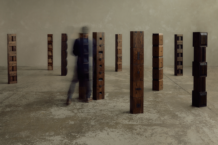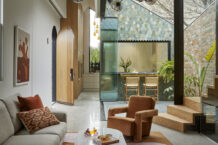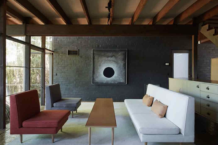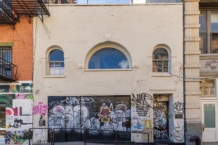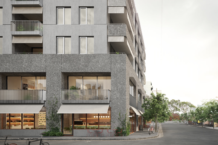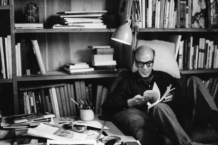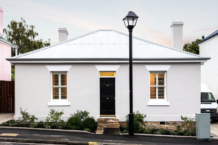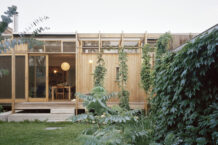A Conversation with Bobby & Steven Clark
Design, People - by Open Journal
-
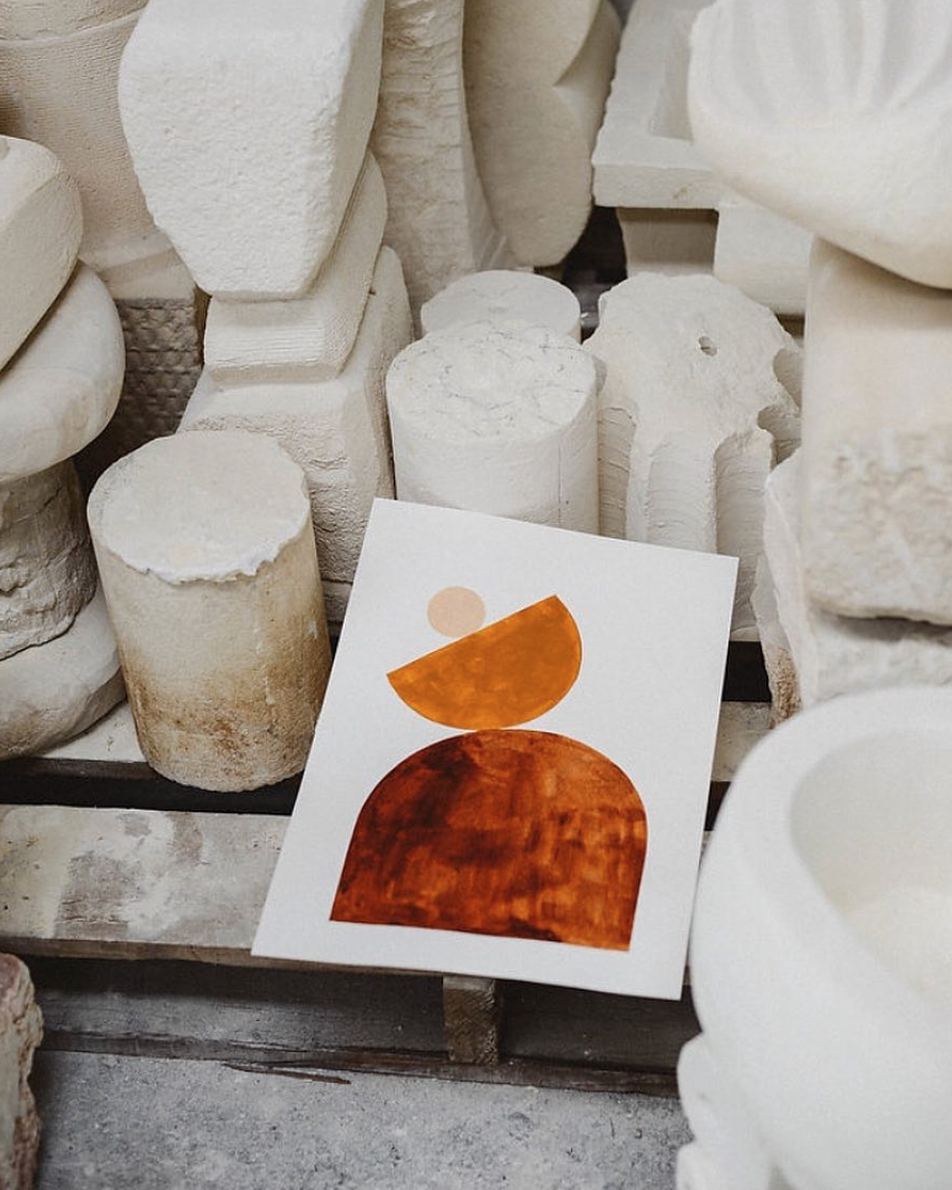
Painting on paper by Bobby Clark. Limestone works by Steven Clark. Image by Bobby Clark
“In some aspects we are complete opposites but we balance each other. I am a dreamer and Steve is a realist.” – Bobby Clark
Melbourne creatives and husband and wife duo Steven and Bobby Clark are complementary parts of a unity that seemingly harnesses the elusive balance between creative and entrepreneurial whilst cementing just how deeply similar we can be as humans. They are each others support, healthy competition, and the source of each other’s pride. A quick glance at their respective bodies of creative work leaves an impression of both the absolute difference (predominantly white limestone sculptural works from Steven – aka Den Holm – and earthy toned paintings on paper from Bobby) and underlying similarities between their aesthetics, and this is a poignant definition of them as a couple. United through difference and the ability to push each other, these two stretch the metaphorical elastic that ties them together as a couple, knowing they will ultimately then be pulled back towards each other.
The obvious similarities in form depicted in both Bobby and Steven’s work despite their differing mediums held a fascination coming into this interview. Even their approach to the interview itself was widely varying (Bobby carefully typed her beautifully considered responses whilst Steven preferred a chat that veered on and off the gist of the conversation in an endearingly affable way) and yet both fundamentally conveyed a united front, astoundingly similar expectations, and a deep-seated understanding of each other’s quirks and attributes.

A study in form. The work of Bobby and Steven Clark. Image by Bobby Clark.
OJ: How would you describe your work / life balance and the grey zones between them?
B: Our work/life balance is something we definitely need to work on. We both love what we do and work for ourselves so switching off is hard. We haven’t had a holiday in over 4 years. We have recently been through something that has taught us to slow down and take time for ourselves. It made us realise that the balance could be better.
S: I’m not sure anyone ever finds that balance. I think it’s a myth. I do try to change things up by playing sport though. That is my way of relaxing as it’s the most removed I can be from my art. It helps me to switch off and think about only one other thing.
OJ: What elements do you absolutely need in your work environments in order to get the creative and productive juices flowing?
B: My environment is important in general. I need windows, natural light, and white walls. I love to look outside while I work. Working from home can be quite lonely so seeing what’s going on outside helps. I always surround myself with books, magazines, and my own work before I start and always work with music or a documentary playing in the background.
S: Not any one particular thing although lighting is huge! The natural light is a massive positive in my studio. For me though, the most important thing is having the ability to do what I want. I used to rent space from Pop and Scott which was amazing but because the space was ultimately theirs I was naturally limited with what I could do to it. Having the freedom to move and change and draw on the wall is important. I tend to move my entire arm when I draw, as opposed to just the wrist and elbow, so my process is heavily based on drawing one-to-one and my studio walls are the most available canvas.

Bobby’s home studio. Image by Lara Cooper.

Den Holm studio. Steven’s process involves using his studio walls as a canvas. Image by Liz Sunshine.
OJ: How does your relationship influence your work? Do you critique each other or is your role more supportive and confidence boosting? Do you enjoy collaboration?
B: I really value Steven’s opinion more than anyone else’s. He’s the person I share everything with first. There’s definitely a balance of both critique and support, he doesn’t hold back in giving his honest opinion whether it be good or bad, which I respect. He was the driving force for me to start painting again and is also a huge inspiration. His passion for what he does inspires me to evolve and develop my practice. He really does amaze me as a person and through his work. I feel incredibly lucky that we have each other.
S: Indirectly. We bounce off each other a lot. I’ve always been quite a competitive person (probably from playing sport) and Bobby’s just realised that she is too. If one person comes home with great news we are equal parts happy and slightly jealous which adds a really healthy level of motivation to my own work and the support I have for Bobby. We’ve come to realise that having each others backs, and not getting in each others way when it comes to what we love and want to do, is really important.
OJ: You’ve been together for more than a decade now and no doubt weathered a lot of change in that time. How would you describe the dynamic between you that has allowed your professions to continue to flourish? Would you say you take risks or are circumstantial and lifestyle changes the result of more calculated musings?
B: In some aspects we are complete opposites but we balance each other. I am a dreamer and Steve is a realist. We are both quite adaptable and extremely hard working and ambitious with very similar morals and views on life. Over the last few years life has thrown some pretty unexpected obstacles our way which has deviated us from our plan, but we adapt well and aren’t afraid to take risks in order to achieve our goals.
S: I’m more of the planner. I have more of a vision of where I want to be but not a clear path to it which means the destination is never a fixed thing. Coming to Australia from Scotland is a good example. Australia was supposed to be a stopgap. We were going to London from Manchester but thought to come to Australia to work for a year. A year later we realised we needed to figure out a way to stay. So I went back working as a stonemason for nearly 5 years which was the best path to getting to our endpoint.
OJ: If not Australia, where would you both live and why?
B: Our journey to living in Australia permanently is a long way from complete so we have had to think about where we would go next if we can’t stay here long term. Berlin is somewhere I would like to explore more. I could see us having a life there. Maybe Copenhagen, Denmark or New York. I can be talked into living anywhere really, especially by Steve.
S: Maybe somewhere in the country. Not in a big city. I’m in Byron Bay now and it’s really made me realise that I’d want to settle next to the sea and in a rural area. I would like to stay here in Australia though.

Both Bobby and Steven concentrate on form, balance, and composition in the aesthetic of their work. Image by Liz Sunshine.
OJ: How do your creative processes differ/align? You both seem heavily influenced by the geometric shape and both of your works have a very calming aura surrounding them. However, your materiality and communication methods are vastly different…
B: Our creative processes are entirely different. My space needs to be clutter free and organised whereas Steve’s is busy and full, with materials and tools on every surface. I need space and order and start with a blank surface and blank mind. Steve starts with a lot of thoughts. His work has to have a backstory, a mood, or a feeling.
S: Very different. Even the way we tidy the house is different! I stack everything together in one big pile (4 clean rooms and one messy one) and then systematically tackle that pile. Bobby walks through each room and tidies as she goes. We’ve learnt to divide and conquer when it comes to our totally different approaches to everything.

Steven’s Den Holm studio. Image by Liz Sunshine
OJ: Your work stems from very multi-faceted backgrounds. Textiles, fashion and set design for Bobby and textiles, furniture, and sculpture for Steven. Have your paths been considered or evolutionary? Do you see your current mediums as your forever mediums or will there be further shifts in the future?
B: My path is undeniably evolutionary. The path to where my work is now was long and varied. For some reason I never wanted to study fine art and thought studying fashion and textiles would be the best way to form a creative career. I was always told being an artist wasn’t realistic. I’m so glad I took that route now as that’s where Steve and I met. I think taking an alternative route makes my work multifaceted and adaptable.
My work is constantly evolving. I would like to experiment with different mediums increasing the scale of my work and moving onto canvas. I’m in the process of developing my work into 3D structures. I would love to experiment with environmental art and also move across into products, print, and fashion.
S: There will 100% be more shifts. I don’t see stone as my medium moving forward. I’m trying a textile mix with stone at the moment. Even dipping into embroidery. My process is a bit of a melting pot of different materials and mediums and I like to see where it goes. I get excited by materials and want to work with more. I’m also experimenting with the waste produced through my current work and how that can be modified for re-use. The end product is like a limestone terrazzo I use to make tiles.

Material studies at Den Holm. Image by Liz Sunshine.
OJ: What is it about the Australian (Melbourne) creative landscape that has led to you both putting down roots here? How does it differ from Scotland and other major cities?
B: I found Melbourne’s creative industry really nurturing and encouraging, even when starting out. People were very supportive and accepting which I found really refreshing as the market is fiercely competitive and guarded at home.
S: Timing. And it kinda does help that I’m Scottish. That I’m a foreigner. It’s a point of difference that gets your foot in the door. That’s really important in art and anything creative so I definitely think that being foreign set me apart in Australia and made my work unique. Where I grew up in Scotland, stonemasonry is a common and inevitable career path. Here it is unique and interesting and seen from a totally different perspective.
OJ: Do you think your artworks are more suited to a specific environment or translate across multiple interior styles?
B: I would like to think that both our works translate across many different environments and interior styles but I don’t think that’s for us to decide what kind of space the art will end up.
S: Definitely different. At the moment I’m working with different dyes and different materials and these inform different results that are suited to all kinds of environments. Sculpture vs. tiles for example.

Bobby’s work in situ. Styling by Rowena Moore. Image by Tatjana Plitt.
OJ: In an ideal world, what would your perfect home look like and how would it function?
B: I think it would be an ongoing project. I dream up our future home all the time. It will be close to the beach, with lots of space, hopefully with enough space that we can both have our own separate studios full of art and sculptures with lots of texture and interesting forms. We always laugh about having separate bathrooms on each side of our bedroom and separate dressing rooms. I’m a clean freak and Steve is the exact opposite (messy as hell!) so he can have his very own space to make as much mess as possible. Our dream home will have functional spaces with clever, concealed storage. All of our rented homes have had next to no built-in storage and spaces that haven’t been well considered in terms of function so that will be our priority.
S: I think we’ll buy an old house and do that up first. Definitely going to happen.
Contact details to purchase or commission work can be found here for Bobby and here for Steven.
Interview conducted by Tiffany Jade.

